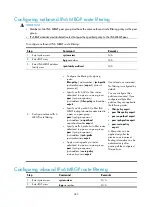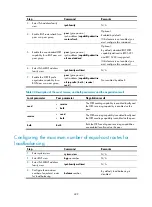
430
Configuring a large scale IPv6 MBGP network
Configuration prerequisites
Before you configure the following tasks, you must configure basic IPv6 MBGP functions.
Configuring an IPv6 MBGP peer group
For easy management and configuration, you can organize some IPv6 MBGP peers that have the same
route update policy into a peer group. A policy configured for a peer group applies to all the members
in the group.
IMPORTANT:
•
To create an IPv6 MBGP peer group, you must enable an existing IPv6 unicast peer group in IPv6 MBGP
address family view.
•
Before adding an IPv6 MBGP peer to the IPv6 MBGP peer group, you must add the corresponding IPv6
BGP unicast peer to the corresponding IPv6 BGP unicast peer group.
To configure an IPv6 MBGP peer group:
Step
Command
Remarks
1.
Enter system view.
system-view
N/A
2.
Enter BGP view.
bgp
as-number
N/A
3.
Enter IPv6 address family view.
ipv6-family
N/A
4.
Create an IPv6 BGP peer group.
group
ipv6-group-name
[
external
|
internal
]
N/A
5.
Add a peer to the peer group.
peer
ipv6-address
group
ipv6-group-name
[
as-number
as-number
]
No peers are added by
default.
6.
Enter IPv6 MBGP address family
view.
ipv6-family multicast
N/A
7.
Enable the configured IPv6
unicast BGP peer group to create
the IPv6 MBGP peer group.
peer
ipv6-group-name
enable
N/A
8.
Add the IPv6 MBGP peer into the
peer group
peer
ipv6-address
group
ipv6-group-name
No peers are added by
default.
Configuring IPv6 MBGP community
A peer group enables a group of peers to share the same policy, and a community enables a group of
IPv6 MBGP routers in multiple ASs to share the same policy. The community attribute is propagated
among IPv6 MBGP peers and not restricted to AS boundaries.
You can reference a routing policy to modify the community attribute for routes sent to a peer. In addition,
you can define extended community attributes as required.
















































